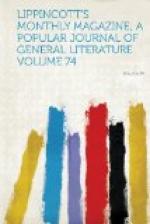The first landing-place of the vast staircase and the ante-room at the top of it are lined with the more interesting and perfect of the pagan inscriptions which the recent movements of the soil have brought to light. Of course, the majority of these present no specialties distinguishing them from the thousands of similar inscriptions with which the world has long since been familiar. But there are some among them which contribute useful fragments of knowledge to the attempts of our antiquaries to construct a satisfactory plan of the ancient city—dedications of statues, showing what god or goddess inhabited such or such a shrine, and the like. The letters of these inscriptions have been rendered more easily legible by restoring the scarlet coloring of them, as has been done in the case of those at the Vatican.
The visitor next enters a very long corridor or gallery giving access to the various halls and rooms, and adorned with a series of modern busts of the men of whom Italy has most reason to be proud. Some among them are of much merit.
Then comes the gallery of the bronzes. In this department the late finds have been very numerous and extremely interesting. Among the objects which will immediately attract the visitor’s eye as he enters the principal room are a litter and a biga or chariot. In both cases of course only fragments of the bronze remain, but they are sufficient to have enabled skilled antiquaries to reconstruct the entire litter and the entire chariot. The latter is very specially interesting. The plates of embossed and chiseled bronze which encased the body of the chariot are figured with admirably-worked subjects in basso-rilievo, many of them relating to the “wondrous tale of Troy.” This invaluable specimen was the gift to the museum of that eminent and liberal




